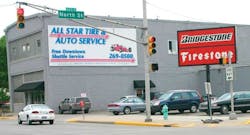"Your ‘Check engine’ light is on, Penny.” That’s a running gag on “The Big Bang Theory” television series on CBS. After six seasons, Penny’s car has yet to have engine trouble despite the warning.
It is never a laughing matter when the “Check engine” or “Service engine soon” light is glowing. At a minimum, it is an irritant to the driver.
If the warning isn’t heeded, it could signal the need for a rebuilt or new engine that will cost thousands of dollars. Those of you who don’t perform major engine work will never see that money.
At this time of year, with the summer heat still lingering and fall only a month away, what should you be checking after you get the vehicle up on the lift? With college students preparing to drive back to school (or be driven back by their parents), what should you be looking for or looking to do to make sure the vehicle is trustworthy?
Preventive maintenance is the key. Running an engine diagnostic isn’t a bad place to begin. The owner of All Star Tire & Auto Service Co. in Indianapolis says inspecting the tires and brakes is a good starting point.
Dan Williford, marketing director for Aftermarket Auto Parts Alliance Inc., stresses the importance of batteries and wiper blades. “We think it’s important for dealers to start running battery checks,” he says. “And they shouldn’t charge for the service. Shops are losing money because they are trying to charge for battery and wiper installation when parts suppliers like AutoZone don’t.”
Batteries are especially susceptible to the extreme heat of summer and cold of winter. “If the battery is older than two years, it should be tested by a qualified technician to make sure it has the starting power to handle the stress of extreme temperatures,” says Steve Popovich, managing director of the American Automobile Association (AAA) East Central’s Automotive Service Department.
Regardless of what you inspect first, be thorough. And follow a checklist.
[PAGEBREAK]
All Star service
All Star Tire & Auto Service is located in downtown Indianapolis, minutes from the State Office Building Complex, City Government Building, Federal Building, Market Square Arena, Lucas Oil Stadium — and just three blocks away from Indiana University-Purdue University Indianapolis. The urban university caters to more than 30,000 students.
“We run an ad in the campus newspaper,” says Bernie Cooper, owner of All Star Tire. “The parents, students and school staff trust their cars with us.”
Cooper says for back-to-school service, he inspects the tires and brakes first. “For the brakes, check the wear as well as the pressure of the pedal. Are the rotors worn and scratched? Rusted? Are the pads worn? And we check the brake fluid level. It’s all part of the interval maintenance schedule.” As for the tires, tread depth, wear, inflation and alignment need to be checked because “any of them might need some attention.” All Star Tire offers storage for out-of-season winter and summer tires.
The cooling system and antifreeze are checked next, “because in the Midwest, winter arrives before you know it.”
The 73-year-old, family-owned business was started by Cooper’s father, Irvin Cooper. “Our niche is the ability to offer the customer who works or lives in the Indy downtown area the convenience of professional tire and automotive service while they work at their office,” says Cooper. That includes a free downtown shuttle service.
“We also cater to vacation or business travelers from the nearby hotels as well as local shoppers who enjoy the ambience of our wonderful downtown area. This leaves their weekends free for other, perhaps more enjoyable pursuits.”
All Star Tire services all domestic and imported cars and light trucks, although it specializes in high performance tire sales to European and Asian imports. Do high-end vehicles require a different maintenance checklist?
“We start with our vehicle inspection checklist,” says Cooper. “All vehicles are treated the same — up to the point where a more sophisticated vehicle may have performance or safety options not usually seen on the more mundane vehicles, such as blowers, superchargers, advanced computerization including telemetry, or a diesel engine or no internal combustion engine at all.”
For example, one of Cooper’s customers is a Tesla owner who brings his car in for new tires. Inspections are performed not by the dealership but by the factory through a telemetric computer connection at 2 a.m. — or as necessary — in the owner’s home garage.
“We find that the content of the vehicle inspection (with the noted exception of the Tesla) is the same from vehicle to vehicle regardless of cost or age.
“Rather, the difference is between the customers, as some see their vehicles as a means of transport, like a horse or a bicycle, while others take great pride in knowing and caring about their vehicle.
“Both customers pay the bills around here, but I really enjoy listening and learning from those folks who have taken the time to learn about their ‘ride,’ and understand and appreciate good service.” ■
Seeing the light
Using a Ford Focus as an example, if the “Service engine soon” light is blinking, the engine is misfiring, according to the Ford Focus Owner’s Manual.
“Under engine misfire conditions, excessive exhaust temperatures could damage the catalytic converter, the fuel system, interior floor coverings or other vehicle components, possibly causing a fire.”
If the light stays illuminated, the On Board Diagnostics System (OBD-II) has detected a malfunction. Either way, maintenance is required.
As for the engine oil and filter, the manual says it should be changed every 7,500 miles.




